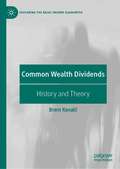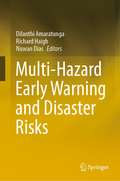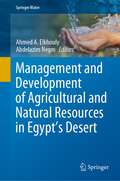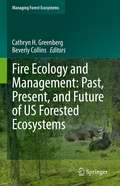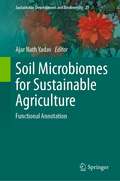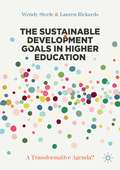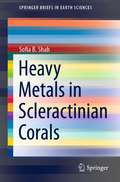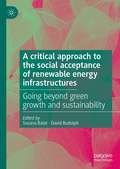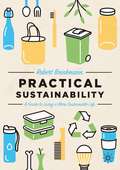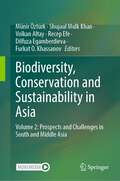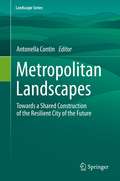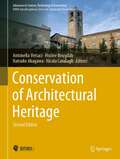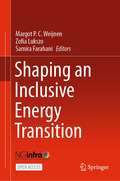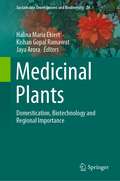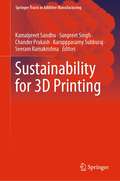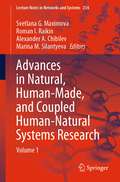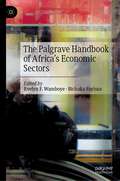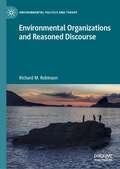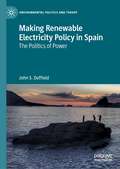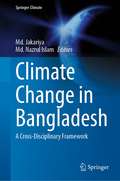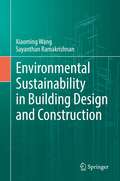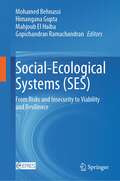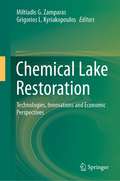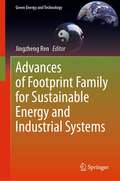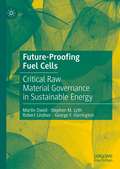- Table View
- List View
Common Wealth Dividends: History and Theory (Exploring the Basic Income Guarantee)
by Brent RanalliCommon wealth dividends are universal cash payments funded by fees on the private use of common resources like land, minerals, and the atmosphere as a carbon sink. Thomas Paine’s 1797 pamphlet Agrarian Justice and Alaska’s Permanent Fund Dividend are staples in the literature on Basic Income, but there is much more to common wealth dividends beyond these highlights, and common wealth dividends have a distinctive ethical justification and distinctive policy implications that merit discussion. This monograph, the most comprehensive study of common wealth dividends to date, will be of interest to students, teachers, and advocates of Basic Income and those in the field of environmental studies, including sustainable development, natural resource management, and climate policy.
Multi-Hazard Early Warning and Disaster Risks
by Dilanthi Amaratunga Richard Haigh Nuwan DiasThis book presents a collection of papers under the theme of multi-hazard early warning and disaster risks. These were selected from the presentations made at the International Symposium on Tsunami and Multi-Hazard Risks, Early Warning and Community Awareness in supporting implementation of the Sendai Framework for Disaster Risk Reduction 2015-2030. This conference aimed to recognize achievements and to highlight work that still needs to be carried out. The conference promoted collaboration among academia, research institutions and disaster management offices, and further encouraged multidisciplinary and multi-sectoral interactionThis International Symposium on Multi-Hazard Early Warning and Disaster Risk Reduction provided an important opportunity to reflect upon our progress to date in tackling disaster risk, but also to consider some of the challenges and opportunities that lay ahead of us.A particular focus of this event wasMulti-Hazard Early Warning. During the negotiations for the Sendai Framework, countries and partners highlighted the need to:1. Continue to invest in, develop, maintain and strengthen people-centred, end-to-end early warning systems;2. Promote the application of simple and low cost early warning equipment and facilities;3. Broaden the dissemination channels for early warning information to facilitate early action.Countries also called for the further development of and investment in effective, nationally compatible, regional multi-hazard early warning mechanisms. To address these needs, global Target (g) of the Sendai Framework was adopted, namely to “substantially increase the availability of and access to multi-hazard early warning systems and disaster risk information and assessments to the people by 2030”. As illustrated by recent events in Indonesia, it is also vital to address the challenge of cascading hazards that pose a tsunami risk, and the importance of linking tsunami early warning to a multi-hazard environment. However, moving towards a multi-hazard environment is complex and poses many challenges but can bring significant benefits in terms of efficiencies and also in recognising the links between hazards, such as cascading threats. We very much hope that this book will provide an important platform to address these and other challenges in addressing disaster risk, as well as supporting implementation of the Sendai Framework for Disaster Risk Reduction
Management and Development of Agricultural and Natural Resources in Egypt's Desert (Springer Water)
by Abdelazim Negm Ahmed A. ElkhoulyThis book reviews the economic potential of various natural resources found in the Egyptian deserts that could help fill the food gap in Egypt, e.g., the date palm, olives, and domestic animals. Bearing in mind that the entire country is subject to arid or hyperarid climatic conditions, only a small portion (3% of total area) is agriculturally productive in comparison, the dominant deserts. These aspects, combined with a growing population (ca. 100 million citizens) and water resources scarcity, have produced severe adverse effects on natural resource utilization. This book presents innovative methods for addressing desert soil's key problems (soil erosion, salinity, pollution, decreased fertility, minerals, and weed and pest control). Its goal is to help authorities reclaim the desert and optimally utilize the minerals and the available natural resources to support the sustainability agenda 2030. Besides, it offers researchers guidance on remaining gaps and future research directions. Lastly and importantly, it provides essential information on investment opportunities in desert cultivation, such as the fields of food, fodder, and medicinal plants.
Fire Ecology and Management: Past, Present, and Future of US Forested Ecosystems (Managing Forest Ecosystems #39)
by Beverly Collins Cathryn H. GreenbergThis edited volume presents original scientific research and knowledge synthesis covering the past, present, and potential future fire ecology of major US forest types, with implications for forest management in a changing climate. The editors and authors highlight broad patterns among ecoregions and forest types, as well as detailed information for individual ecoregions, for fire frequencies and severities, fire effects on tree mortality and regeneration, and levels of fire-dependency by plant and animal communities. The foreword addresses emerging ecological and fire management challenges for forests, in relation to sustainable development goals as highlighted in recent government reports. An introductory chapter highlights patterns of variation in frequencies, severities, scales, and spatial patterns of fire across ecoregions and among forested ecosystems across the US in relation to climate, fuels, topography and soils, ignition sources (lightning or anthropogenic), and vegetation. Separate chapters by respected experts delve into the fire ecology of major forest types within US ecoregions, with a focus on the level of plant and animal fire-dependency, and the role of fire in maintaining forest composition and structure. The regional chapters also include discussion of historic natural (lightning-ignited) and anthropogenic (Native American; settlers) fire regimes, current fire regimes as influenced by recent decades of fire suppression and land use history, and fire management in relation to ecosystem integrity and restoration, wildfire threat, and climate change. The summary chapter combines the major points of each chapter, in a synthesis of US-wide fire ecology and forest management into the future.This book provides current, organized, readily accessible information for the conservation community, land managers, scientists, students and educators, and others interested in how fire behavior and effects on structure and composition differ among ecoregions and forest types, and what that means for forest management today and in the future.
Soil Microbiomes for Sustainable Agriculture: Functional Annotation (Sustainable Development and Biodiversity #27)
by Ajar Nath YadavThis book encompasses current knowledge of soil microbiomes and their potential biotechnological application for plant growth, crop yield, and soil health under the natural as well as harsh environmental conditions for sustainable agriculture. The microbes are ubiquitous in nature. The soil is a natural hotspot of the soil microbiome. The soil microbiome plays a critical role in the maintenance of global nutrient balance and ecosystem functioning. The soil microbiomes are associated with plant ecosystems through the intense network of plant–microbe interactions. The microbes present in bulk soil move toward the rhizospheric region due to the release of different nutrients by plant systems. The rhizospheric microbes may survive or proliferate in rhizospheric zone depending on the extent of influences of the chemicals secreted into the soil by roots. The root exudates contain the principal nutrients factors (amino acids, glucose, fructose, and sucrose). The microbes present in rhizospheric region have capabilities to fix atmospheric nitrogen, produce different phytohormones, and solubilize phosphorus, potassium, and zinc. The plant systems take these nutrients for their growth and developments. These soil and plant associated microbes also play an important role in protection of plants from different plant pathogenic organisms by producing different secondary metabolites such as ammonia, hydrogen cyanide, siderophores, and hydrolytic enzymes. The soil microbiomes with plant growth-promoting (PGP) attributes have emerged as an important and promising tool for sustainable agriculture. The soil microbiomes promote the plant growth and enhance the crop yield and soil fertility via directly or indirectly different plant growth-promoting mechanism. The soil microbes help the plant for adaptation in extreme habitats by mitigating the abiotic stress of high/low temperatures, hypersalinity, drought, and acidic/alkaline soil. These PGP microbes are used as biofertilizers/bioinoculants to replace the harmful chemical fertilizers for sustainable agriculture and environments.The aim of the book “Soil Microbiomes for Sustainable Agriculture” is to provide the recent advances in mechanisms of plant growth promotion and applications of soil microbiomes for mitigation of different abiotic stresses in plants. The book is useful to scientists, researchers, and students related to microbiology, biotechnology, agriculture, molecular biology, environmental biology, and related subjects.
The Sustainable Development Goals in Higher Education: A Transformative Agenda?
by Wendy Steele Lauren RickardsThis book explores the role universities have to play in fulfilling the Sustainable Development Goals (SDGs). At the heart of “sustainable development” is the legacy of unsustainable development with its roots in modernity and colonialism. Critical engagement with the SDGs involves recognising these roots are shared by universities and the reciprocal need for maintenance, repair and regeneration. Universities are not just enablers of change, but also important targets of change. By focusing on the role of education about, for and through the SDGs, the authors seek to advance critical engagement with higher education that is both progressive and meaningful. We are all responsible for bearing witness to our age. This book will appeal to all those who hope that more sustainable future worlds are still possible.
Heavy Metals in Scleractinian Corals (SpringerBriefs in Earth Sciences)
by Sofia B. ShahThis book provides an in-depth review of heavy metals in corals, describing the sources of heavy metals in the marine environment and their effect on corals. It is designed to serve as a unique reference for upcoming marine researchers and chemists, advanced undergraduate and postgraduate students as well as those interested in marine pollution with respect to heavy metals. The book explains the basics as well as the state-of-the-art regarding heavy metals and corals and is engaging and clearly written and narrated, providing readers with the fundamental tools about the subject matter that they need in their specific fields. It allows readers to understand and appreciate the interactions between the atmosphere, ocean, and the geosphere. Detailed reference is included for the benefit of the reader. The specific objectives of this book are (i) to inform/educate the reader about persistent pollutants such as heavy metals, (ii) to identify sources of heavy metals in the marine environment, (iii) to inform about route of exposure and uptake of the heavy metal pollutants by corals, (iv) to elaborate about the effect of heavy metal pollutants on the coral reef ecosystems, (v) to discuss the ways in which heavy metal regulation occurs in corals, (vi) to impact current knowledge regarding heavy metals in the marine environment, and (vii) to briefly show chemical analysis and instrumentation for analyzing heavy metals.
A critical approach to the social acceptance of renewable energy infrastructures: Going beyond green growth and sustainability
by Susana Batel David RudolphThis book provides a critical approach to research on the social acceptance of renewable energy infrastructures and on energy transitions in general by questioning prevalent principles and proposing specific research pathways and lines of inquiry that look beyond depoliticised, business-as-usual discourses and research agendas on green growth and sustainability. It brings together authors from different socio-geographical and disciplinary backgrounds within the social sciences to reflect upon, discuss and advance what we propose to be five cornerstones of a critical approach: overcoming individualism and socio-cognitivism; repoliticisations – recognising and articulating power relations; for interdisciplinarity; interventions – praxis and political engagement with research; and overcoming localism and spatial determinism: As such, this book offers academics, students and practitioners alike a comprehensive perspective of what it means to be critical when inquiring into the social acceptance of renewable energy and associated infrastructures.
Practical Sustainability: A Guide to a More Sustainable Life
by Robert BrinkmannThis book will teach you everything you need to know about sustainable living—from reducing your greenhouse gas footprint to making sure that you are part of the green economy. Along the way, readers will learn about the field of sustainability and the “three E’s” of sustainable living—environment, economy, and equity. We are in the midst of great environmental change and all of us need to do everything we can to try to live more gently on the planet. Robert Brinkmann provides a range of options for readers as to what they can do to try to make a difference. Some involve simple lifestyle changes - but he also challenges all of us to commit to make more difficult and more meaningful changes to create a greener, more sustainable world. The book also delves into how we can create more sustainable communities, schools, and organizations. It showcases many examples of people and organizations that are making significant contributions to improving our planet’s sustainability that serve as inspiration and guidance for all of us trying to live more sustainably.
Biodiversity, Conservation and Sustainability in Asia: Volume 2: Prospects and Challenges in South and Middle Asia
by Dilfuza Egamberdieva Münir Öztürk Recep Efe Volkan Altay Shujaul Mulk Khan Furkat O. KhassanovOf the world’s seven continents, Asia is the largest. Its physical landscapes, political units, and ethnic groups are both wide-ranging and many. Southwest, South and Middle Asia are highly populated regions which, as a whole, cover an extremely large area of varied geography. In total, this domain is unique in its plant diversity and large vegetation zones with different communities and biomes. It is rich in endemics, with specific and intraspecific diversity of fruit trees and medicinal plants, including a number of rare, high value, species. At the same time, much of the land in the region is too dry or too rugged, with many geographical extremes. Overgrazing, oil and mineral extraction, and poaching are the major threats in the area. This two-volume project focuses on the dynamic biodiversity of the region with in-depth analysis on phytosociology, plants, animals and agroecology. There are also chapters that explore new applications as well as approaches to overcome problems associated with climate change. Much of the research and analysis are presented here for the first time. We believe this work is a valuable resource for professionals and researchers working in the fields of plant diversity and vegetation, animal diversity and animal populations, and geo-diversity and sustainable land use, among others.The first volume guides our readers to West Asia and the Caucasus region, while volume two focuses on issues unique to South and Middle Asia.
Metropolitan Landscapes: Towards a Shared Construction of the Resilient City of the Future (Landscape Series #28)
by Antonella ContinThis edited volume covers many aspects of the Metropolitan Landscapes. Solutions are needed to meet the demand of the citizens of a renewed metropolitan region landscape. It opens up discussions about possible toolkits for strategic actions based on understanding the territory from geographical, urban, architectural, economic, environmental, and public policy perspectives. This book intends to promote the Metropolitan dwelling quality, ensuring human well-being proposing a discussion on the resilient articulation of the interface space among the city's infrastructure, agriculture, and nature.This book results from the Symposium: Metropolitan Landscapes that MSLab of the Politecnico di Milano and ETSA (Sevilla) organized at the IALE 2019 Conference (Milan, July 2019) to manage radical territory transformation with a strategic vision. The widespread growth of urban areas indicates the importance of building resilient sustainable cities capable of minimizing climate-change impact production.The Symposium aimed to discuss the Urban Metabolism approach considering the combination of Landscapes set in a single Metropolitan Ecosystem. Accordingly, new design strategies of transformation, replacement or maintenance can compose Urban-Rural Linkage patterns and a decalage of different landscape contexts. Ecological interest in environmental sustainability, compatibility, and resilience is not tied exclusively to the balance between production and energy consumption. Thus, it is the integration over time and at several scales of the urban and rural landscapes and their inhabitants that nourish the Metropolitan Bioregion.Moreover, the Metropolitan Landscape Book's research hypothesis is the need for a Glossary, strengthening the basis of understanding Metropolitan Landscape's complexity.This book's topic is particularly relevant to Landscape Urbanism, Architecture, Urban disciplines Scholars, Students and Practitioners who want to be connected in a significant way with Metropolitan Discipline’s research field.
Conservation of Architectural Heritage (Advances in Science, Technology & Innovation)
by Hocine Bougdah Natsuko Akagawa Antonella Versaci Nicola CavalagliThis book focuses on the management and conservation of architectural heritage with the aim of increasing awareness about the value of such conservation and of saving what is left of history, which in turn rewards societies by supporting the tourism industry, generating economic return, and preserving communities’ identities.Since it has become an essential need to manage and conserve the architectural heritage in order to protect the identity and heritage of a city, there appeared a gap between the theory and its application. Therefore, a considerable amount of attention has been directed by experts in this field toward emphasizing the contribution of heritage conservation in order to inspire the development of imaginative, useful high-quality design.
Shaping an Inclusive Energy Transition
by Zofia Lukszo Margot P. C. Weijnen Samira FarahaniThis open access book makes a case for a socially inclusive energy transition and illustrates how engineering and public policy professionals can contribute to shaping an inclusive energy transition, building on a socio-technical systems engineering approach. Accomplishing a net-zero greenhouse gas emissions economy in 2050 is a daunting challenge. This book explores the challenges of the energy transition from the perspectives of technological innovation, public policy, social values and ethics. It elaborates on two particular gaps in the design of public policy interventions focused on decarbonization of the energy system and discusses how both could be remedied. First, the siloed organization of public administration fails to account for the many interdependencies between the energy sector, the mobility system, digital infrastructure and the built environment. Cross-sector coordination of policies and policy instruments is needed to avoid potentially adverse effects upon society and the economy, which may hamper the energy transition rather than accelerate it. Second, energy and climate policies pay insufficient attention to the social values at stake in the energy transition. In addressing these gaps, this book intends to inspire decision makers engaged in the energy transition to embrace the transition as an opportunity to bring a more inclusive society into being.
Medicinal Plants: Domestication, Biotechnology and Regional Importance (Sustainable Development and Biodiversity #28)
by Kishan Gopal Ramawat Halina Maria Ekiert Jaya AroraMedicinal plant research is an evergreen subject. There is a tremendous increase in popularity of herbal medicine in traditional medicine, ethnomedicine, modern medicine and as over the counter food supplements. Even after this increased demand, supply is neither uniform nor assured as most of these plants are collected from wild. In developing countries of tropical and subtropical regions where majority of herbal drugs are produced, this is not organised sector making it vulnerable to several malpractices, hence standardization of all aspects required. This has also negative impact on biodiversity and conservation of plants as well as supply of uniform material. This book is aimed to provide up to date information about sustainable use of selected medicinal plants, their active ingredients and efforts made to domesticate them to ensured uniform supply. Development of agrotechnology, biotechnology and cultivation practices using conventional and non-conventional methods are presented. Where these efforts will lead the medicinal plant research and future perspective are discussed. The chapters are written by well recognised group leaders in working in the field. The book contains topics on general biology of medicinal plants, their sustainable use and, cultivation and domestication efforts. A uniform chapter structure has been designed to keep consistency. The book will be useful for academicians, agriculturists, biotechnologists and researcher, and industries involved in manufacturing herbal drugs and supplementary products.
Sustainability for 3D Printing (Springer Tracts in Additive Manufacturing)
by Seeram Ramakrishna Chander Prakash Sunpreet Singh Karupppasamy Subburaj Kamalpreet SandhuWith advancement in modern technology human life span in 21st century has significantly improved as compared to past centuries. Indeed, the manufacturing and household wastes have also boosted in the same era, presenting a hazardous condition to the various living beings. However, through smart methodologies, it can be possible to recycle/reuse of the different types of wastes as a feedstock convenient for specialized manufacturing technologies, such as 3D printing. This means that through proper facilities the waste can be used as the raw material for the printing technologies with characteristic at par with the virgin feedstock. Furthermore, producing the feedstock using waste materials will help to reduce the cost of the processing material, productivity and eco-friendliness of this manufacturing technology. This book will cover a boarder aspect of such efforts wherein various applications and state of art solutions will be discussed in a comprehensive way. This book will be much interest for academics, research and entrepreneur who are working in the field materials science, 3D printing, and manufacturing because of its coverage of state of art solution in the field of commercial, industrial and healthcare products.
Advances in Natural, Human-Made, and Coupled Human-Natural Systems Research: Volume 1 (Lecture Notes in Networks and Systems #234)
by Svetlana G. Maximova Roman I. Raikin Alexander A. Chibilev Marina M. SilantyevaThis book is a collection of cutting-edge and cross-disciplinary studies on natural, human-made, and coupled human-natural systems, addressing the challenge of developing integrated knowledge from multiple disciplines. The authors explore the structure, function, and dynamic mechanisms of various systems, both natural and human-made, as well as analyze their reciprocal interactions under the concept of “coupled human-natural systems.” These interactions are used to understand feedback, nonlinearities, thresholds, time lags, legacy effects, and path dependencies, emerging across multiple spatial, temporal, and organizational scales. In other words, this book is a collection of advanced research on unique properties of natural and human-made systems, as well as human-environment dynamics, reciprocal relationships, and cross-scale interactions.The authors outline prospects on building a holistic view of social development and coherent sustainability. Among the topics covered are the following: human networks research; adaptation of local people to social and environmental challenges; coupled dynamics of socioeconomic and environmental systems; critical issues in social science climate change research; education for greater sustainability; peace, justice, and strong institutions; advances in cultural traditions and strategies for social stability; innovative development and barriers to sustainable development; economic systems in the age of digital changes and unstable external environments. The scholars analyze how more effective technologies can enhance resilience, reduce vulnerability, and minimize human impacts on natural systems, taking into consideration critical thresholds to prevent harmful feedback to human systems.The authors grasp the complexity of systems by integrating knowledge of constituent subsystems and their interactions. The framework developed by the authors is used to integrate human and natural systems for achieving greater sustainability, covering critical threats, challenges, and best governance approaches and practices. The research results obtained from studies on coupled human-natural systems are stronger, the authors argue, if compared with traditional (discipline) approaches.
The Palgrave Handbook of Africa’s Economic Sectors
by Evelyn F. Wamboye Bichaka FayissaThis handbook provides a reference resource to showcase insightful and nuanced perspectives on Africa’s agriculture, industry, services, and manufacturing sectors; factors affecting the sectors’ competitiveness; and the sectors’ contribution to employment, economic growth, and sustainable development. It also addresses the potential benefits that the sectors could harness from the planned Continental Free Trade Area (CFTA), and in particular how CFTA could increase the efficiency and competitiveness of these sectors.This book provides evidence-based holistic analyses of the past and current state of Africa’s economic sectors, with a strong emphasis on tangible and specific policy recommendations for the purpose of enhancing future economic growth, employment, and sustainable development of the continent. It also assesses the impact of the first-ever Continental Free Trade Area in Africa, and its potential implications for Africa’s integration into regional and global economy and competitiveness relative to other fast developing economies (such as those in Asia). This handbook gives an in-depth analysis of fundamental domestic factors that have relevance on the sectors’ expansion and growth and their contributions to employment, economic growth, and sustainable development in Africa with differential effects across the continent.
Environmental Organizations and Reasoned Discourse (Environmental Politics and Theory)
by Richard M. RobinsonThis book explores the meaning and role of “fair and reasoned discourse” in the context of our institutions for environmental decision processes. The book reviews the roles of our “environmental advocacy organizations”—such as The Sierra Club, The Audubon Society, the Environmental Defense Fund—in providing and ensuring that our discourse and decisions are fair and reasoned according to the criteria of being (i) inclusive of input from all affected, (ii) informed of relevant scientific and socio-economic information, (iii) uncorrupted by direct conflicts of interest, and (iv) logical according robust review by uncorrupted judges. These organizations are described and examined as expressions of “collective imperfect duty,” i.e. the coordinated duties with environmental direction. The current state of our discourse is examined in light of this fairness criteria, particularly in consideration of the cross-border problems that threaten tragedies of the global commons.
Making Renewable Electricity Policy in Spain: The Politics of Power (Environmental Politics and Theory)
by John S. DuffieldThis book examines the politics of renewable electricity policy in democratic Spain. It provides the first comprehensive political analysis of how and why successive Spanish governments have increased or reduced support for renewable power, especially wind and solar. In particular, it identifies the key influences that have been brought to bear on decision making by the core executive as it has sought to determine the appropriate role of renewable sources in the country’s electricity mix. Following the introduction, four chapters chart the dramatic rise, fall, and, most recently, renewed rise in support for utility-scale renewable power, from the early 1980s to the present. Another chapter details the decade-long political struggle over the regulation of small-scale distributed renewable electricity generation. The penultimate chapter explores the future prospects for renewable power in Spain, and the final chapter offers an overarching explanation of the patterns of policy outcomes observed.
Climate Change in Bangladesh: A Cross-Disciplinary Framework (Springer Climate)
by Md. Nazrul Islam Md. JakariyaThis book is a comprehensive resource for climate change impacts and scenarios on cross-cutting issues in Bangladesh and other tropical low-lying countries in Asia. The book promotes mitigation and adaptation strategies for learning and innovation to tackle climate change impacts, reduce inequality, as well as include changes in food, energy, health, education, and social protection policies in Bangladesh and Asian low-lying countries.Through several case studies, this book provides a powerful framework for identifying management tools and their applications in environment and governance including; climate change and natural hazards, climate change and energy framework, gender inequality and capacity building, and community participants and the actions needed to protect them.The aim of this book is to provide information to scientists, practitioners, academics, and government and non-government policy-makers to help them better understand the particularities of climate change adaptation and mitigation strategies for cross-cutting issues in Bangladesh.
Environmental Sustainability in Building Design and Construction
by Xiaoming Wang Sayanthan RamakrishnanThis monograph offers analyses of construction activities using various key concepts and assessments of sustainable development, and provides students and researchers with methodologies and design aspects for the sustainable development of the built environment. Additionally, the book demonstrates various national and international policies for assisting architects, engineers and policy makers in understanding the relevant decision-making approaches to sustainable development in construction. The book begins by reviewing the background of sustainability and sustainable development. The focus then turns to the effects of climate change on the built environment, including impacts of energy and carbon emissions, as well as constraints on water and waste management. The remaining chapters discuss the necessary approaches to achieve sustainable waste management, energy efficient building design, and resilience and adaptation in the built environment In eight chapters, the book encourages readers to think independently, logically and objectively about the complex issues presented by the applications of sustainable development in construction, including resource efficiency, environmental impacts, human health, building economics and social development.
Social-Ecological Systems (SES): From Risks and Insecurity to Viability and Resilience
by Mohamed Behnassi Gopichandran Ramachandran Himangana Gupta Mahjoub El HaibaThis book contributes to the multidisciplinary debate about social–ecological systems (SES) within the perspective of rethinking the nature of interaction between these systems, especially in the Anthropocene Era. Most chapters either deliberate on risk dynamics threatening current SES or stimulate thought processes to manage such risks and related negative implications. After analyzing the main drivers of SES vulnerability, the book highlights the shifts to be made to enhance the sustainability and resilience of these systems, mainly the integration and restructuring of governance frameworks, the reorganization of production and consumption systems far from conventional models based on consumerism, the elaboration of mitigation, adaptation, and SDGs implementation measures from a co-benefit perspective, and the consideration of appropriate approaches and paradigms while elaborating and implementing response mechanisms. This volume is relevant to researchers/experts, students, practitioners, and decision-makers from different scales and spheres.
Chemical Lake Restoration: Technologies, Innovations and Economic Perspectives
by Miltiadis G. Zamparas Grigorios L. KyriakopoulosThis book aims to structure, in a complete and sequential way, the mainstream technical knowledge which is related to eutrophication control. The book considers the development of innovative technologies for phosphate removal, while supporting the restoration of currently degraded lakes and reservoir systems. In addition, this book contains key-aspects of future benchmark interests being specially framed under the ongoing development of a circular economy. In particular, the book will contribute to a better understanding of the problem of internal P-loads and P-sources disposition towards a more effective control of nutrients’ enrichment in lakes. The chemical routes and environmental fate of such lake nutrients will be viewed in the light of innovative technologies (engineering dimensions) and circular economy perspectives (economics dimensions). The main theme extends to an economic appreciation of environmental polluted aquifers. The book will appeal to an interdisciplinary audience, covering a wide spectrum of scientific fields, such as environment, physical chemistry, surface chemistry, interfacial phenomena, coastal engineering, bio-engineering, environmental policy makers, and economists.
Advances of Footprint Family for Sustainable Energy and Industrial Systems (Green Energy and Technology)
by Jingzheng RenThis book presents various methodologies for determining the ecological footprint, carbon footprint, water footprint, nitrogen footprint, and life cycle environment impacts and illustrates these methodologies through various applications. In particular, it systematically and comprehensively introduces the concepts and tools of the ‘footprint family’ and discusses their applications in energy and industrial systems. The book begins by providing an overview of the effects of the economic growth dynamics on ecological footprint and then presents the definitions, concepts, calculation methods, and applications of the various footprints. The unique characteristic of this book is that it demonstrates the applications of various footprints in different systems including economic system, ecological system, beef production system, cropping system, building, food chain, sugarcane bioproducts, and the Belt and Road Initiative. Providing both background theory and practical advice, the book is of interest to energy and environmental researchers, graduate students, and engineers.
Future-Proofing Fuel Cells: Critical Raw Material Governance in Sustainable Energy
by Robert Lindner Martin David Stephen M. Lyth George F. HarringtonAs the world accelerates towards a renewable energy transition, the demand for critical raw materials (CRMs) for energy generation, conversion, and storage technologies is seeing a drastic increase. Such materials are not only subject to limited supply and extreme price volatility but can also represent serious burdens to the environment, to human health, and also to socio-political systems. Taking an interdisciplinary perspective, this book provides a novel perspective on the discussion about material dependencies of energy technologies. It examines CRMs use in fuel cells, an emerging energy conversion technology, and discusses governance strategies for early-stage fuel cell development to predict and avoid potential issues. This will be an invaluable resource for researchers in energy studies, engineering, sociology and political science as well as those with a general interest in this field looking for an accessible overview.
